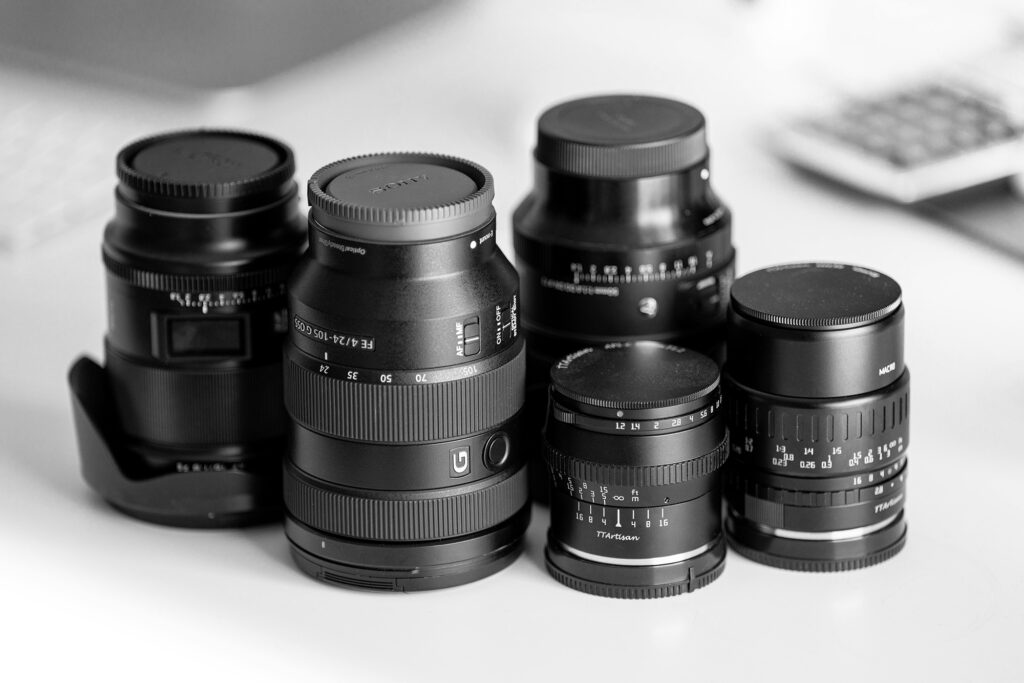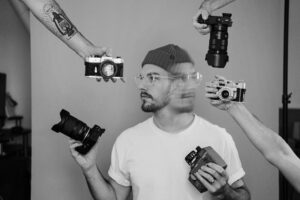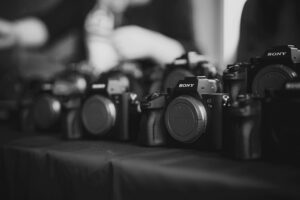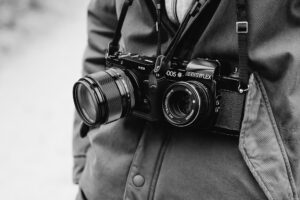Not all lenses are created equal, and the best lens for your work depends entirely on what you shoot. Whether you’re capturing portraits, documenting street life, or filming travel videos, each creative goal has its ideal lens type. In this post, we’ll help you choose the best lens for different styles of photography and videography. We’ll also explain why certain focal lengths, apertures, or features matter more for each use case, so you can invest in lenses that actually fit your shooting style.
If you’re not yet familiar with the main types of camera lenses, I recommend reading this first.
TL;DR
- For everyday and travel photography, a lightweight zoom lens with a wide focal range (like 24-105mm) is ideal.
- Portrait photography shines with fast prime lenses: 50mm, 85mm; or short telephoto with wide apertures (f/1.8 or f/1.4).
- Landscape photography benefits from wide-angle lenses with sharp corners and minimal distortion.
- Sports and wildlife photographers should look for fast telephoto or super-telephoto lenses with image stabilization.
- Street and documentary work often use 35mm or 50mm primes: small, discreet, and versatile.
- Event photography calls for fast zooms (like 24-70mm f/2.8) to adapt quickly to changing scenes.
- Macro lenses let you capture extreme close-ups of tiny details like insects, flowers, or textures.
- For video and content creation, stabilized wide or standard zooms work best, especially for handheld and vlogging setups.
This post is just one part of my “Lens Buying Guide“, which you can download as a pdf file right now.
1. Best Everyday and Travel Lens for Beginners
When you’re traveling or shooting casually, compactness and versatility matter. You’ll want to reduce the size and weight of your gear so everything fits in a small camera bag. That’s why a versatile zoom lens with a wide focal range (like 24-105mm or even 24-70mm) is ideal, it lets you shoot landscapes, portraits, and everything in between without switching lenses.
If you have space and need more creative control, you could also carry a compact prime lens. Just keep in mind that constantly changing lenses can be time-consuming and risky, especially in dusty or humid environments.
2. Best Portrait Photography Lenses (Studio & Outdoor)
For portraits, a lens with a wide maximum aperture (like f/1.8 or f/2.8) and shallow depth of field will help you create soft backgrounds and flattering subject isolation when needed. While some zoom lenses (like 70-200mm f/2.8) perform well, prime lenses are often the go-to choice for portraits because of their superior image quality and lower cost.
Avoid wide-angle lenses for close-up portraits, as they can distort facial features. A 50mm or 85mm prime is perfect for most portrait work.
3. Best Lens for Landscape and Nature Photography
For landscape photography, you’ll typically want a wide-angle lens (16-35mm or 24mm prime). Because you’ll often use narrower apertures (like f/8-f/16) to keep the whole scene sharp, maximum aperture isn’t a top priority here.
Instead, focus on optical quality and edge-to-edge sharpness. Cheap kit lenses often fall short in this department, so it’s worth investing in a better lens if you want crisp, professional results.
For more on evaluating performance, see my guide on lens sharpness and optical quality.
4. Best Lens for Street Photography and Documentary Work
Street and documentary photographers are split between two camps: some prefer wide-angle lenses (like 24mm or 35mm) that let you get close and immerse yourself in the scene; others lean toward standard primes (like 50mm) to maintain a natural distance and avoid disrupting the environment.
Telephoto lenses are not recommended for street photography. They create a sense of surveillance and can make people uncomfortable. Smaller, low-profile lenses are best for staying discreet and blending in.
5. Top Lenses for Sports and Wildlife Photography
Whether you’re shooting in a stadium or out in the wild, you’ll often be far from your subject. That makes telephoto and super-telephoto lenses (usually 200mm to 600mm) the best option.
Look for a lens with fast autofocus and image stabilization. A wide maximum aperture (like f/2.8 or f/4) is also helpful for freezing motion and isolating your subject.
6. Best Lenses for Events, Weddings, and Live Coverage
Event photographers need to work in tight spaces, often without much freedom to move. A good wide or ultra-wide lens lets you capture full scenes even in crowded rooms or auditoriums. Just make sure the lens doesn’t have heavy distortion, since people are your main subjects, you want them to look natural.
You’ll also need a standard or short telephoto lens for tighter shots and portraits during the event. A fast zoom lens like a 24-70mm f/2.8 is a popular all-in-one choice for event coverage.
7. Best Lens for Close-Ups and Macro Photography: Flowers, Insects, and Small Details
When shooting flowers, insects, jewelry, fabrics, or architectural textures, nothing beats a macro lens. These lenses offer 1:1 magnification and close focusing distances, making it easy to capture tiny details with exceptional clarity.
They’re also great for still life, product photography, or scientific documentation.
8. Best Lens for Video and Content Creation
If video is a big part of your work, prioritize a lens with image stabilization and smooth focus operation. In DSLR systems, stabilization is usually in the lens. In mirrorless systems, it’s often built into the camera body, but having both is ideal.
Wide or standard zooms (like 16-35mm or 24-70mm) are great for handheld video. Avoid telephoto lenses unless you’re using a tripod, as camera shake is more noticeable at long focal lengths.
For vlogging or filming yourself, go with a wide lens (like 20mm) to keep framing comfortable. Some professionals shoot with standard primes, but beginners and solo creators will appreciate the flexibility of a stabilized wide zoom.
If you want to go one step further, you can look into cinema lenses too.
Final Tips for Choosing the Right Lens
Now that you know what to look for, here are a few final tips:
- Cover the range. Over time, aim to build a kit that spans roughly 20mm to 200mm. A combination of two zooms and one fast prime is a solid, flexible setup for most creators.
- Invest in at least one prime. Even if you mostly shoot with zooms, a single prime lens with a wide aperture will give you more creative control and better performance in low light.
- Think long-term. Before buying a lens, ask yourself: Will I still be able to use this if I upgrade my camera?
- If you switch brands, you’ll likely need an adapter, and may lose autofocus or other features.
- If you upgrade from an APS-C (crop sensor) to a full-frame camera within the same brand, most crop-sensor lenses will still mount, but your images will be cropped and lower resolution.
- Full-frame lenses, on the other hand, work on both crop-sensor and full-frame bodies without issue (aside from the change in effective focal length).
So, if you’re planning to upgrade soon, it’s often smarter to invest in full-frame lenses, even if they’re a bit heavier and pricier.
Reminder: This post is just one part of my “Lens Buying Guide“, which you can download as a pdf file right now.
Last Words
When choosing the best lens, don’t chase specs alone, think about how and where you’ll actually use it. One photographer’s favorite portrait lens might be a travel creator’s worst nightmare. If you’re just starting out, go with versatile zooms that cover wide to medium telephoto, then add prime lenses as you refine your style. And remember: the best lens is the one that helps you stay creative, not just the one with the biggest price tag or fanciest features.
FAQ
Can I use the same lens for both photography and video?
Yes, many lenses work well for both, but video often benefits from lenses with smooth focusing and minimal focus breathing.
Which focal length is most versatile?
A 24-70mm zoom lens is one of the most versatile options for both photography and video.
Are prime lenses better than zoom lenses for video?
Not always. Prime lenses can offer sharper images and wider apertures, but zooms are more flexible for changing compositions quickly.




